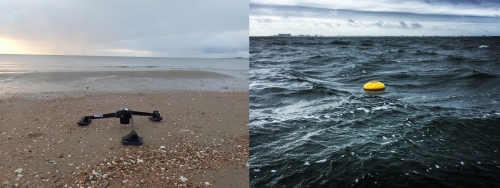R.A.J. Jaarsma1*, M. Daugharty2, M.A. van der Lugt1, M.A. de Schipper1
1 Delft University of Technology
2 Nortek Netherlands B.V.
*corresponding author:
Introduction
ADCPs, widely used for measuring water motions in the water column, are associated with large investments, complex programming, demanding deployment operations, and extensive data processing. Nortek's Eco was designed to overcome these barriers with a ready-to-use, portable current profiler at an accessible price point (Velasco et al., 2020). Designed for applications in relatively shallow waters, the Eco is suitable for sampling tidal currents, wind driven circulations and rip currents in coastal areas and estuaries. It can be deployed on foot with its mounting frame or released from a dock, floating platform, or small vessel with the Eco pop-up buoy system (Figure 1). Study questions include: Is the Eco an accessible instrument for the inexperienced user? What are the viable potential uses of a simplified instrument with minimal user input requirements?
Methods
To explore this question, deployments were carried out at the Prins Hendrikzanddijk at the island of Texel as part of the SEDMEX field campaign of the TU Delft and Utrecht University. A range of high-end instrumentation installed along the beach was used for validation. The Eco was deployed in the 20 m deep tidal channel Texelstroom with the buoy, and with the mounting frame at the shallow underwater platform close to the beach. One of the nearshore deployments encompassed the subject of research into an emerging salient, a geomorphic feature formed by accretion in the lee side of an offshore shallow zone.
Results
The study showed that current profiles can easily be obtained with the Eco due to built-in deployment options, lightweight form, and a user friendly interface for programming and data processing. Its limited size enabled deployments with small weights (<50 kg), thus enabling deployment by one or two persons without specialized vessels. While high-end instrumentation allows for advanced configurations and high resolution measurements, the Eco's portability and flexibility enable spontaneous deployments, without the need for prior experience in ADCP observations. It proved to be the right instrument to capture flow patterns around the salient that emerged outside the range of the installed measurement arrays. Short, investigative deployments can be made to scout out conditions to optimize future campaigns. Hence, the instrument can be a valuable tool for dedicated applications in coastal and estuarine studies.

Figure 1: The Nortek Eco deployed at the field site using its tripod bottom mount and buoy system.
References
Velasco, D., Jørgensen, M., Nesheim, A., & Nylund, S. (2020). Development of a low cost, self-configuring ADCP and integrated deployment and recovery system. Global OCEANS 2020. Singapore.
I. Surname1*, F.N. Another-Surname2 , Y. Next-Surname2
1 University Name, Country; 2 Organization Name, Country
* Corresponding author: mail.name@organization.org


